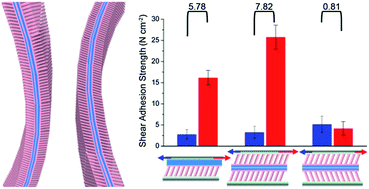Gecko-inspired bidirectional double-sided adhesives†
Abstract
A new concept of gecko-inspired double-sided adhesives (DSAs) is presented. The DSAs, constructed by dual-angled (i.e. angled base and angled tip) micro-pillars on both sides of the backplane substrate, are fabricated by combinations of angled etching, mould replication, tip modification, and curing bonding. Two types of DSA, symmetric and antisymmetric (i.e. pillars are patterned symmetrically or antisymmetrically relative to the backplane), are fabricated and studied in comparison with the single-sided adhesive (SSA) counterparts through both non-conformal and conformal tests. Results indicate that the DSAs show controllable and bidirectional adhesion. Combination of the two pillar-layers can either amplify (for the antisymmetric DSA, providing a remarkable and durable adhesion capacity of 25.8 ± 2.8 N cm−2 and a high anisotropy ratio of ∼8) or counteract (for the symmetric DSA, generating almost isotropic adhesion) the adhesion capacity and anisotropic level of one SSA (capacity of 16.2 ± 1.7 N cm−2 and anisotropy ratio of ∼6). We demonstrate that these two DSAs can be utilized as a facile fastener for two individual objects and a small-scale delivery setup, respectively, complementing the functionality of the commonly studied SSA. As such, the double-sided patterning is believed to be a new branch in the further development of biomimetic dry adhesives.


 Please wait while we load your content...
Please wait while we load your content...